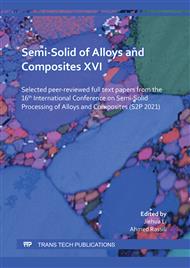[1]
O. Trudonoshyn, O. Prach, Multistep nucleation and multi-modification effect of Sc in hypoeutectic Al-Mg-Si alloys, Heliyon 5 (2019) 1-12.
DOI: 10.1016/j.heliyon.2019.e01202
Google Scholar
[2]
G.B. Burger, A.K. Gupta, P.W. Jeffrey, and D. J. Lloyd, Microstructural control of aluminum sheet used in automotive applications, Mater. Charact. 35 (1995) 23-39.
DOI: 10.1016/1044-5803(95)00065-8
Google Scholar
[3]
S. Ji, F. Yan, and Z. Fan, Development of a high strength Al-Mg2Si-Mg-Zn based alloy for high pressure die casting, Mater. Sci. Eng. A 626 (2014) 165-174.
DOI: 10.1016/j.msea.2014.12.019
Google Scholar
[4]
L.F. Mondolfo, Aluminum Alloys: Structure and Properties, Butterworth, London, (1976).
Google Scholar
[5]
R.A. Rosenberg, M.C. Flemings, H.F. Taylor, Nonferrous binary alloys hot tearing, Trans. AFS 68 (1960) 518-528.
Google Scholar
[6]
D.G. Eskin, Suyitno, L. Katgerman, Mechanical properties in the semi-solid state and hot tearing of aluminum alloys, Prog. Mater. Sci. 49 (2004) 629-711.
DOI: 10.1016/s0079-6425(03)00037-9
Google Scholar
[7]
W. I. Pumphrey, D. C. Moore, Cracking during and after solidification in some aluminium copper magnesium alloys of high purity, J. Inst. Met. 75 (1948) 425-438.
Google Scholar
[8]
F. Wang, H.K Dong, Z. Wang, P.L. Mao, Z. Liu, Hot tearing behavior of Mg-5Al-xCa alloys, Acta Metall. Sin. 53 (2017) 211-219.
Google Scholar
[9]
P.H. Jennings, A.R.E. Singer, W.I. Pumphrey, Hot-shortness of some high-purity alloys in the systems aluminium-copper-silicon and aluminium-magnesium-silicon, J. Inst. Met. 74 (1947) 227-248.
Google Scholar
[10]
D. Argo, M. Pekguleryuz, P. Vermette, and M. Lefebvre, Die Casting 2001, Cincinnati, OH, North American Die Casting Association, Chicago, IL, 2001, pp.181-186.
Google Scholar
[11]
G. Vinodh, H.R. Jafari Nodooshan, D.J. Li, X.Q. Zeng, B. Hu, J.T. Carter, and A.K. Sachdev, Effect of Al content on hot-tearing susceptibility of Mg-10Zn-xAl alloys, Metall. Mater. Trans. A 51A (2020) 1897-1910.
DOI: 10.1007/s11661-020-05657-9
Google Scholar
[12]
B. Hu, D.J. Li, J.Y. Wang, Z.X. Li, X.Y. Wang, X.Q. Zeng, Hot tearing behavior in double ternary eutectic alloy system: Mg-Ce-Al Alloys, Metall. Mater. Trans. A 51 (2020) 6658-6669.
DOI: 10.1007/s11661-020-06046-y
Google Scholar
[13]
B. Hu, D.J. Li, Z.X. Li, J.K. Xu, X.Y. Wang, X.Q. Zeng, Hot tearing behavior in double ternary eutectic alloy system: Al-Mg-Si Alloys, Metall. Mater. Trans. A 52 (2021) 789-805.
DOI: 10.1007/s11661-020-06101-8
Google Scholar
[14]
Pandat-Phase Diagram Calculation software package for Multicomponent Systems, Computherm LLC, Madison, WI 53719, (2001).
Google Scholar
[15]
T.W. Clyne, G.J. Davies, Solidification and Casting of Metals, The Metals Society, London, 1979, pp.275-278.
Google Scholar
[16]
J.F. Song, F.S. Pan, B. Jiang, A. Atrens, M.X. Zhang, Y. Lu, A review on hot tearing of magnesium alloys, J. Magn. Alloy. 4 (2016) 151-172.
DOI: 10.1016/j.jma.2016.08.003
Google Scholar
[17]
R.A. Dodd, W.A. Pollard, J.W. Meier, Hot tearing of magnesium casting alloys, Trans. AFS 65 (1957) 100-117.
Google Scholar
[18]
M.O. Pekguleryuz, P. Vermette, A study on hot-tear resistance of magnesium diecasting alloys, Trans. AFS 114 (2006) 729-734.
Google Scholar
[19]
W.I. Pumphrey, P.H. Jennings, A consideration of the nature of brittleness at temperature above the solidus in castings and welds in aluminum alloys, J. Inst. Met. 75 (1948) 235-256.
Google Scholar
[20]
J. Liu, S. Kou, Effect of diffusion on susceptibility to cracking during solidification, Acta Mater. 100 (2015) 359-368.
DOI: 10.1016/j.actamat.2015.08.064
Google Scholar
[21]
J. Vero, The hot shortness of aluminum alloys, Met. Ind. 48 (1936) 431-442.
Google Scholar
[22]
Z. Wang, Y.D. Huang, A. Srinivasan, Z. Liu, K.U. Kainer, N. Hort, Influences of Y additions on the hot tearing susceptibility of Mg-1.5 wt.% Zn alloys, Mater. Sci. Forum 765 (2013) 306-310.
DOI: 10.4028/www.scientific.net/msf.765.306
Google Scholar
[23]
G. Cao, S. Kou, Hot tearing of ternary Mg-Al-Ca alloy castings, Metall. Mater. Trans. A 37 (2006) 3647-3663.
DOI: 10.1007/s11661-006-1059-x
Google Scholar
[24]
M. Bassan, B. Buonomo, G. Cavallari, E. Coccia, S. D'Antonio, V. Fafone, L. G. Foggetta, C. Ligi, A. Marini, G. Mazzitelli, G. Modestino, G. Pizzella, L. Quintieri, F. Ronga, P. Valente, Measurement of the thermal expansion coefficient of an Al-Mg alloy at ultra-low temperatures, Int. J. of Mod. Phys. B 27 (2013) 1-12.
DOI: 10.1142/s0217979213501191
Google Scholar


